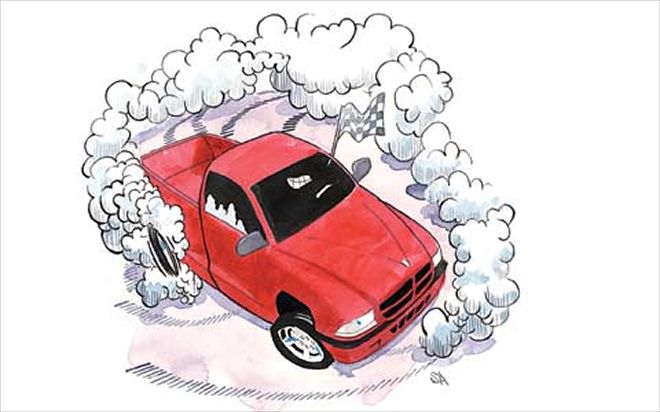Building Too Much HeatQ:I bought a new '01 Dodge Dakota with the 4.7-liter engine, auto, air, and the H.D. coolant package. The truck now has 45,000 miles on the odometer. Lately, I've been experiencing an overheat problem when climbing steep grades. The Dakota seems to operate at normal temperatures on the highway or stop-and-go traffic. On steep grades, it gets up to 245-degrees Fahrenheit, and once it got up to 250 after a 10-mile climb. Dodge has replaced the coolant, fan clutch, thermostat, radiator cap, and temperature-sending unit. The problem is still there, and Dodge says the other possibilities are a clogged radiator or a blown head gasket.
A:Testing for radiator obstruction requires the engine be at normal operating temperature (thermostat open) when a small amount of coolant is drained from the system. But here's a serious warning: hot, pressurized coolant can cause injury. Use a rag to cover the radiator cap, then open it slowly to the first stop to vent the pressure to the overflow tank. Once all pressure is released, you can remove the cap. After draining enough coolant to see the coolant tubes through the radiator filler neck, start the engine. At idle you should see the coolant passing through the tubes freely. If there's notable debris obstructing flow, you should reverse-flush the radiator before replacing it. Your best bet is to have it done by a shop with the necessary equipment. Testing for a compression leak at the head gasket involves the installation of a pressure gauge while running the engine and observing any fluctuation or rapid buildup of pressure. Without the gauge, you can remove the radiator cap, thermostat, and drive belt to inspect for bubbles coming up in the radiator after revving the engine a few times to approximately 3000 rpm. Here's something you might want to take into consideration while evaluating the high temperatures: The Dodge overheat diagnostic procedure states that a high-temperature gauge reading during towing or while climbing steep hills may be a temporary condition, and no repair is necessary if gauge readings are normal during all other driving conditions. Higher ambient temperatures and altitudes are also a factor in higher coolant temperatures.
Looking for NoiseQ:I purchased an '02 Chevy Silverado 1500 in January of this year, and it has 18,260 miles on it. I've noticed, when driving at about 45 mph and above, I hear rattling noises like something is vibrating. I've looked inside, outside, and even underneath and can't locate the sound. I'd appreciate any ideas on how to locate this noise. It's not loud, but it is loud enough to be annoying.
A:Vehicle noise can't be accurately diagnosed without being on-site with the appropriate equipment. Get an experienced technician to narrow down the possible causes. There are a number of tools available to aid in locating various noises and vibrations. I did a search for Technical Service Bulletins that may apply to the annoying noise in your Chevy truck. The only one that came close was in reference to a rattling noise coming from the center of the dash. The cause is actually a fuel line in the engine compartment on the other side of the firewall. The fix involves the removal of a cowl-retainer clip and the insulation of the retainer stud to eliminate the hard contact with the fuel line. This condition is typically heard only at idle, but I suggest telling the dealer (you should still be under the manufacturer's warranty) of the TSB I've just described. It may be a different problem the technician has come across before.

| 163 0312 Ttg01 Z
No Bronco GearsQ:The clutch went out on my '87 Ford Bronco II. I installed a new one, put everything back together, and now it acts like there's no clutch at all. It doesn't engage the transmission--I can push it into each gear without any grinding. We tried to bleed the system, thinking the problem might be the master cylinder.
A:The '87 Ford Bronco II equipped with a manual transmission used an internal hydraulic slave cylinder assembly. The cylinder is mounted on the sleeve surrounding the input shaft of the transmission. The hydraulic pressure transmitted from the clutch pedal and master cylinder assembly enables the slave to force the release bearing toward the clutch-pressure plate and release the clutch disc. At this point, you can change gears smoothly. The older models used an external slave cylinder and a release fork that pivots and applies the release bearing. Let's assume it wasn't something silly like forgetting to install the clutch disc, which would produce the symptom you've described--easy in and out of gear and nothing else. Start by disconnecting the hydraulic line at the slave cylinder or opening up the bleeder valve. If doing this now prevents you from shifting into gear with the engine running, then constant pressure to the slave cylinder may be the problem. This can be caused by a fault in the master cylinder or an obstructed hydraulic line that would keep the slave cylinder applied and the clutch released at all times. After that, it's time to pull it apart to make sure the correct parts are there.
| 163 0312 Ttg02 Z
What's That Smell?
Q:I bought an '03 4Runner Sport, and when I accelerate hard, I notice a bad smell, like rotten eggs, in the vehicle. I took it to the dealer who told me this is a known issue but Toyota will not fix it. They gave me an information sheet and sent me on my way. Does this sound right?
A:I'm assuming the information sheet they gave you was Toyota Technical Service Bulletin EG003-03, which came out last February. The TSB applies to all Toyota vehicles and explains the connection between the odor and the sulfur content in gasoline. The more sulfur in the fuel, the more rotten-egg smell comes out of the tailpipe. Sulfur is a normal part of crude-oil products, and the amount present in gasoline can be decreased through the refinement process. Currently, California is the only state that has regulations to limit the gasoline sulfur content for emissions purposes. The remainder of the country's gas-pump standards vary between companies and locations. Assuming your MIL (Malfunction Indicator Lamp) hasn't come on and pointed to a problem in the powertrain-control system, it's time to try a different fuel source. Empty your tank as much as possible, then fill up from one location and gas company at a time to determine which reduces or eliminates the smell.
Steer Me in the Right DirectionQ:I own an '02 Silverado 1500 4x4. Since it reached 2000 miles on the odometer, it's been plagued with a steering knock at the joint of the intermediate steering shafts. Inside the joint is a grease knuckle that can only be filled by disassembling the entire upper steering column--a very poor design. I've had it back to the dealer several times. Do you know of any company that manufactures an aftermarket steering column for a late-model Silverado 1500?
A:If your truck is still covered under the manufacturer's warranty, or if you had the complaint documented prior to the expiration of the warranty, you shouldn't be looking to buy anything at all. The problem involves '99-'02 Chevy and GMC pickups and '00-'02 SUVs. Chevy Technical Service Bulletin 00-02-35-003A details the installation of a steering-column intermediate shaft-lubrication kit (Part #26098419) to repair what it describes as a clunk-type noise coming from under the hood that also can be felt in the steering wheel. These conditions may be more noticeable when turning at low speeds on rough road surfaces. An experienced GM technician told me the lubrication kit usually eliminates the noise when done correctly. He also mentioned something you won't find in the TSB: If any binding of the shaft is noted, the intermediate steering shaft may need to be replaced to avoid a repeat failure. If it hasn't been done already, request the shaft be replaced. If it has been replaced and lubricated properly, the problem may exist elsewhere.

| 163 0312 Ttg03 Z
Used Ram SlippageQ:I bought a used '99 Dodge Ram 1500 with about 69,000 miles on it. My truck shifts into a lower gear for no reason, even when I don't change the throttle position. It's sluggish when the truck goes into lockup and sounds like it's skipping and losing power when going up hills. The transmission has been checked by two different dealers and seems to be okay. I've tuned it up myself and replaced the plugs, wires, TPS, distributor cap, and rotor. I installed a new computer and cleaned and tested the fuel injectors. I've had two different Dodge dealers work on it, and they know something is wrong, but say they don't know what it is. Their computer shows only that the engine is running rich while idling.
A: It may be time to start with the basics, meaning the three common problems with the Magnum engine family. You've already replaced the ignition wires, and an important part of the job on the 5.2-liter V-8 is the proper routing of the wires to avoid a crossfire or ignition-wire induction. Then it'll require a technician to test for a vacuum leak at the intake manifold plenum gasket, which may produce symptoms ranging from a misfire to excessive oil consumption. The third item is reprogramming the Powertrain Control Module, which can eliminate problems with erratic shifting and power loss due to the lock-up torque converter engaging in third gear. The dealership technicians working on your Ram should be careful they haven't missed one of these items during diagnosis. Double-check everything, and if it all looks right, get the service manager at the Dodge dealer involved to stress the issue to help narrow down the problem.
Sensors Like To Be CleanQ:The ABS on my '99 GMC Envoy has been coming on for no reason. When slowly coming to a stop, I can feel the ABS pulsating and making noise as if I'd hit the brakes hard enough to skid--but I'm stopping slowly and the road is fine. I took it to a brake shop, and it hasn't found any trouble codes.
A:Several older GMC and Chevy trucks have experienced low-speed anti-lock-brake operation under normal driving conditions. The cause is a corrosion buildup at the front-wheel speed-sensor mounting surfaces. The buildup increases the air gap between the sensor and the hub reluctor ring, which triggers the sensor with changing wheel speeds. The increased gap causes incorrect readings to be sent to the Electronic Brake Control Module, and the system reacts accordingly by varying hydraulic pressure to the wheel in question. The correction involves testing the voltage output from each sensor, removing the sensors, and cleaning the sensor mounting surface at each hub. This will decrease the air gap and bring the readings back within the correct voltage parameters. The sensors may need to be replaced if excessively distorted. This condition will not set off a diagnostic trouble code. Bring it into a GMC service department where they're more familiar with the problem, as opposed to an outside repair shop.
How To Reach AlexIf you have a technical question regarding your pickup, SUV, or van, feel free to contact Alex, a master technician with the National Institute for Automotive Service Excellence. Send a letter to him in care of Truck Trend Garage, 831 S. Douglas Street, El Segundo, CA 90245, or e-mail us at trucktrend@sourceinterlink.com. Please include the VIN with your question. Due to the volume of questions received every month, we cannot guarantee that everyone's question will be personally answered or will appear in the magazine.
Can't wait for help with a problem you're having with your Truck or SUV? Ask the expert we trust here at Truck Trend Garage--visit Alex Steele at www.RealWorldAutomotive.com.

| 163 0312 Ttg04 Z
 | 163 0312 Ttg01 Z
No Bronco Gears
| 163 0312 Ttg01 Z
No Bronco Gears | 163 0312 Ttg03 Z
Used Ram Slippage
| 163 0312 Ttg03 Z
Used Ram Slippage | 163 0312 Ttg04 Z
| 163 0312 Ttg04 Z